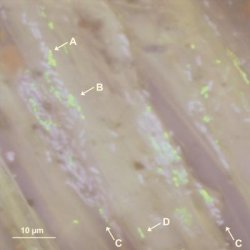





Natural soil is a veritable cornucopia of bacteria, fungi, viruses, and other small organisms, all living together in a delicate balance. Any disruption of that balance can result in one or more of the microbes gaining an upper hand over the others. In some cases, the ones proliferating are pathogenic, or damaging to your plants. Now, imagine a soilless media, practically devoid of any microflora, becoming inoculated with a pathogen. Without competition, the surprise is that any plant growing in such a medium survives! Fortunately, the means to restore a population of beneficial microbes to your soilless medium is available. Read on . . .
In previous articles, I've discussed using specific fungi, such as Trichoderma and mycorrhizae, as effective means for protecting your plants from pathogenic soil microbes. As effective as these can be, teaming them up with others as a group can be even more effective. The theory behind this, of course, is based on the natural state of living soil. Natural soil life is as varied on the microscopic level as virgin forest is on a macroscopic level. This, in part, is why we encounter problems when we try growing certain plants in soilless media. Until relatively recently, the focus has been on the physical characteristics and composition of media, and little thought was given to replicating the soil biota. This oversight, in my opinion, has been a primary cause of the loss or difficulty in growing some of the most desirable of ornamental plants.
Microbes are amazing in their varied natures. Trichoderma (photo, below right), actively attacks interloper microbes to prevent damage to the host plant. Bacillus subtilis (photo, above right) can act to stimulate the natural immune response of plants. Specific Pseudomonas sp. (photo, below left) can promote plant growth through the production of plant growth hormones. You could try throwing together your own concoction of selected microbes and, through trial and error, determine which combination results in the best overall soil biome. This would take a while to work out and you might not have the time to experiment. After all, your goal is not necessarily scientific research, but growing the best vegetables, flowers, potted plants, shrubs and trees that you can. So, what's the alternative?
Fortunately for all of us gardeners, others have done the work, so we don't have to. The results are commercial formulations containing many types and strains of beneficial microflora. Two of these products are Plant Growth Activator (PGA) and Plant Growth Activator Plus (PGA Plus).  The PGA is formulated to be best for plants that thrive in a bacteria-oriented medium; this includes annuals, bulbs, perennials and turf. PGA Plus is designed for plants whose natural biota is fungus-oriented, such as evergreens, conifers and deciduous trees. In my own research work, I've worked with single microbe products, my own biodiverse mixes obtained from combining several single microbe products, and ready-to-use blends, including PGA and PGA Plus. In my own work I have determined that multiple microbe combinations are more effective than a single microbe product alone, and that a comprehensive blend of microbes, vitamins, hormones and plant extracts such as are included in PGA and PGA Plus are the most effective when applied regularly. Over time, your plants will benefit highly from a soilless media that has been invigorated by the addition of a "First Team" of microbes.
The PGA is formulated to be best for plants that thrive in a bacteria-oriented medium; this includes annuals, bulbs, perennials and turf. PGA Plus is designed for plants whose natural biota is fungus-oriented, such as evergreens, conifers and deciduous trees. In my own research work, I've worked with single microbe products, my own biodiverse mixes obtained from combining several single microbe products, and ready-to-use blends, including PGA and PGA Plus. In my own work I have determined that multiple microbe combinations are more effective than a single microbe product alone, and that a comprehensive blend of microbes, vitamins, hormones and plant extracts such as are included in PGA and PGA Plus are the most effective when applied regularly. Over time, your plants will benefit highly from a soilless media that has been invigorated by the addition of a "First Team" of microbes.
These commercial mixes come complete with nutrients to help get the microbes off to a running start. They include many more strains of specific microbes than are available individually.  As for me, I anticipate future innovations by experimenting with my own special brews, adding a pinch of this and a pinch of that, just for good measure! Since the microbes are all beneficial, I don't think you can go wrong if, for example, you have some RootShield and you choose to add it to the PGA mix you are making for your plants. As you work with these products, remember that the living organisms they contain, mean a shorter shelf life than chemical products. They are designed to be used, so use them, don't store them!
As for me, I anticipate future innovations by experimenting with my own special brews, adding a pinch of this and a pinch of that, just for good measure! Since the microbes are all beneficial, I don't think you can go wrong if, for example, you have some RootShield and you choose to add it to the PGA mix you are making for your plants. As you work with these products, remember that the living organisms they contain, mean a shorter shelf life than chemical products. They are designed to be used, so use them, don't store them!
A look at what's coming down the pipeline revealed that a new strain of Bacillus subtilis, with the ability to fight Erwinia infections, is going to be available in the near future. I'm going to obtain some and test it out, as Erwinia bacterial infections are among the most rapid and lethal infections a susceptible plant can get. A perfectly healthy-appearing plant can literally melt into nothingness within a day due to Erwinia infection. Up until now, no truly effective remedy for it has been available. If this new product performs as promised, it will be a genuine breakthrough.
Photos courtesy of Dr. Robert Knaub, Organica Biotech
Copyright © www.100flowers.win Botanic Garden All Rights Reserved